This is the twenty-eighth post in a series about my possible line of descent from Eleanor of Aquitaine. In the first post, I explained how I discovered the possible line, and how I am going to verify it one generation at a time. In the last post, I proved that my twenty-third great-grandmother Margaret, countess of Flanders, was the daughter of Marie of Champagne, countess of Flanders.
Biography
Marie of Champagne was born in the spring of 1171 as the second daughter of Henry, count of Champagne, and Marie of France. Her father also called himself count palatine of Troyes. Marie was just a few months old when her father arranged her marriage. Her intended husband was Baldwin VI, the son of Count Baldwin V of Hainaut and Margaret of Flanders, born in July 1171. The childless Count Philip of Flanders, brother of Margaret, negotiated the marriage for his nephew and heir. The contract was for a double marriage between Flanders and Champagne, since Marie’s brother Henry was engaged to young Baldwin’s sister Elizabeth at the same time, but they never married.1 Marie’s marriage did take place. She married Baldwin VI of Hainaut in January 1186 in Château-Thierry, when they were fourteen years old. The marriage was successful, and the couple was devoted to each other.2
Baldwin V of Hainaut, Marie’s father-in-law, claimed Flanders after the death of Count Philip of Flanders during a crusade in 1191, and ruled Flanders as Baldwin VIII of Flanders in the name of his wife, Margaret of Flanders. Their son Baldwin, Marie’s husband, inherited Flanders after his mother’s death in 1194 and Hainaut after his father’s death in 1195, ruling as Baldwin IX of Flanders and Baldwin VI of Hainaut. As his consort, Marie became countess of Flanders and Hainaut.
Count Baldwin and countess Marie took the crusaders’ oath in 1200 to join the Fourth Crusade. Baldwin departed for the Holy Land in April 1202, while Marie stayed in Flanders to give birth to her daughter Margaret. The crusader army first went to Constantinople, where they ransacked the city and drove the emperor away. Baldwin of Flanders was elected as the new emperor of Constantinople in May 1204. His wife Marie followed him on crusade in 1204 and landed in Acre, where she died before being reunited with her husband.3
A year after he became emperor, Baldwin was taken prisoner by the Bulgarians during the Battle of Adrianopolis. He was never heard from again. His daughter Johanna succeeded him as countess of Flanders and Hainaut. She was succeeded by her sister Margaret.4
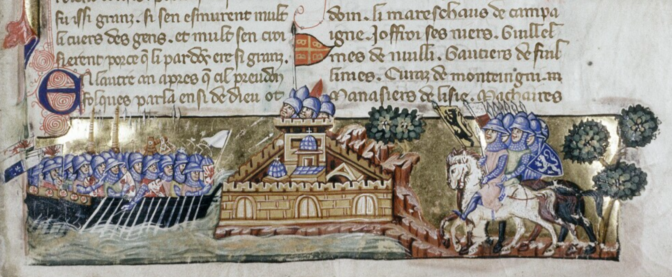
The crusaders, led by the Count of Flanders, reach Constantinople, 1204.5
Marie of Champagne, daughter of Marie of France
The biographical information above was based on modern publications. To prove the identity of the mother of Marie of Champagne according to the Genealogical Proof Standard, we need to go back to the best possible evidence, using original and contemporary records where available, and doing our own analysis.
Chronicles
Most of the details known about Marie’s life came from chronicles. One of the most informative chronicle is Gilbert of Mons’s Chronicle of Hainaut. This segment describes her betrothal in 1171 (abstract from Latin):
At that time Philip count of Flanders came to an agreement with Henry count of Champagne, who had as wife the daughter of the King of France (who had as his third wife the count’s sister) about the marriage between Henry’s oldest son Henry to Elizabeth, the daughter of Baldwin of Hainaut and Margaret, and Baldwin, the young son of Baldwin and Margaret would have as wife Maria the daughter of count Henry, when they were of marriagable age. If one of them died before they married, the next oldest child would fill their place.6
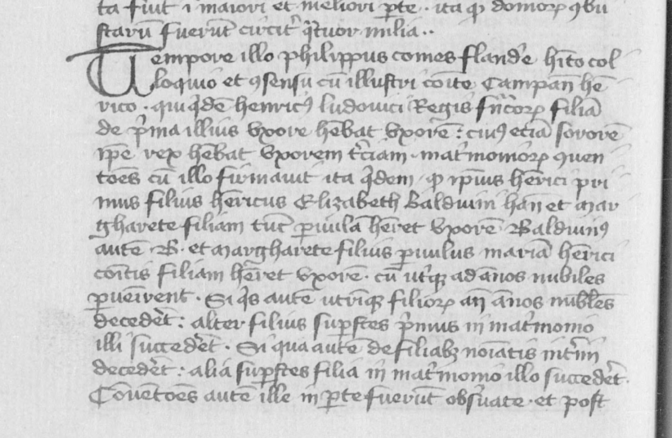
Discussion about the marriage between Baldwin of Flanders and Marie of Champagne
A few pages later discusses the confirmation of the marriage contract in 1179:
In 1179 the count of Hainaut came to a marriage agreement in Troyes with Henry Count Palatine of that city. They betrothed Elizabeth, daughter of the count of Hainaut to Henry son of the count of Troyes, commonly known as count of Champagne, and of the daughter of that count Henry, Maria, to Baldwin son of the count of Hainaut. On the same day, Marie, the wife of count Henry, gave birth to a son Theobald.7
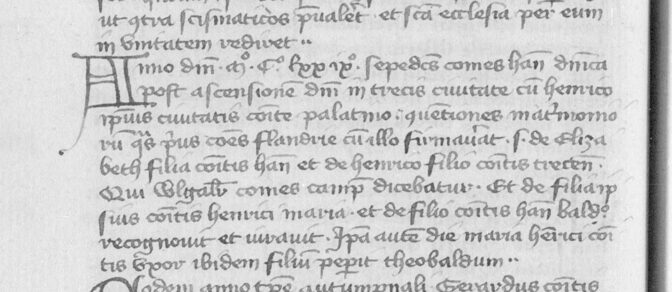
Entry about the betrothal of Marie of Champagne, 1179
The 15th century manuscript shown here is the earliest surviving copy. As discussed in the previous blog post, Gilbert of Mons was the notary and chancellor of the counts of Hainaut and a reliable informant, though we cannot rule out copy errors between the time of his writing around 1200 and the 15th century copy.8
These two sections are in agreement, which makes copy errors less likely. The manuscript shows that Baldwin of Hainaut was betrothed to Marie, daughter of count Henry of Champagne in 1171, confirmed in 1179. Henry was married to the daughter of the King of France. The chronicle is not explicit that she was Marie’s mother, but her inclusion in this paragraph suggest she was. The chronicler was apparently eager to point out the royal connections of the countess of Flanders.
The “Genealogiae Comitum Flandria” [Genealogy of the Counts of Flanders], started in 1120 and continued by various authors over the years, has survived in various manuscript copies. A scholarly publication compared the versions to create an authoritative version.9
One version was continued by an unknown monk at the Clairmarais monastery after 1164. An early copy from the late 1100s survives in the library in Saint Omer, France. Created in France during Marie’s lifetime, it is probably reliable. The manuscript contains the following fragment (corroborated by other versions described in the scholarly publication):
After about four years, Margareta countess of Flanders and Hainaut died. In the county of Flanders she was succeeded by her son Baldwin, whose father Baldwin lived for about another year, whose firstborn son Baldwin took as his wife Maria daughter of Henry count of Champagne whom he had procreated with the daughter of Louis King of France.10
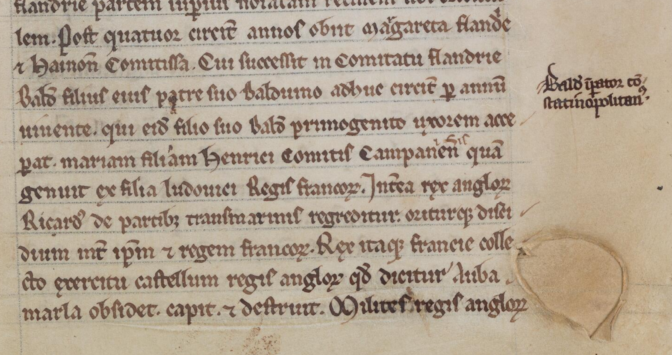
Genealogy of the Counts of Flanders, late 1100s
This shows that Baldwin, son of Baldwin and Margaret of Flanders, married Maria, the daughter of Henry of Champagne and the daughter of King Louis of France. That matches the information in the chronicle by Gislebert of Mons.
Geoffrey de Villehardouin wrote a history of Emperor Baldwin of Constantinople. De Villehardouin was marshall of Champagne and participated in the Fourth Crusade during which Baldwin count of Flanders became emperor of Constantinople. A beautiful illuminated version from the 1200s survives.11
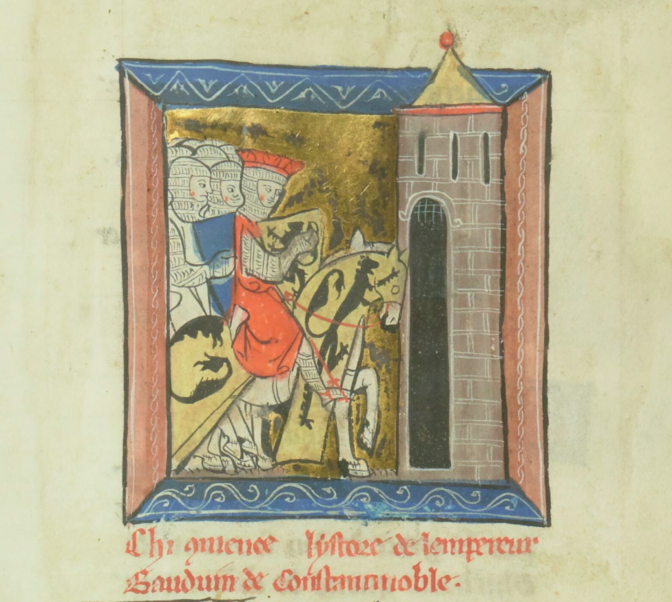
Start of the History of Emperor Baldwin of Constantinople. The Flanders coat of arms showing a black lion on a gold field are displayed on the shield and horse mantling.
The chronicle contains the following fragment (translated from Middle French):
At the beginning of the following lent, on Ash Wednesday [23 February 1200], count Baldwin of Flanders and his wife Marie, who was the sister to Count Theobald of Champagne, took the cross at Bruges.12
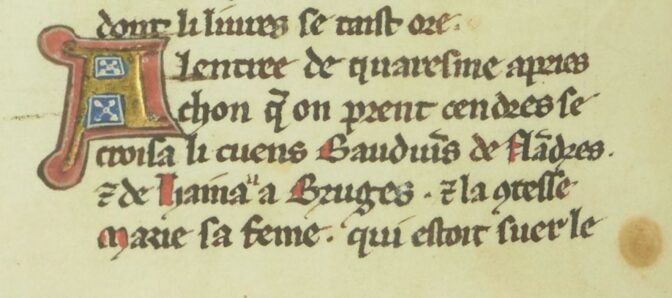
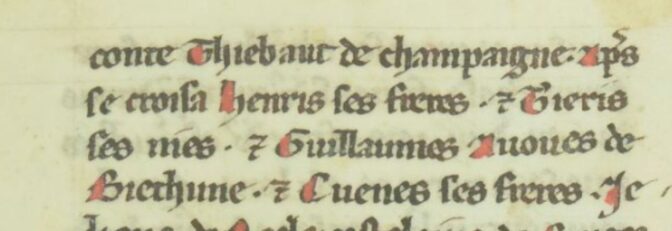
Fragment mentioning Marie as daughter of Henry of Champagne and the daughter of King Louis of France
This shows that Marie, wife of count Baldwin of Flanders, was the sister of count Theobald of Champagne. That matches the information from the chronicle of Gislebert of Mons that showed Henry having a son Theobald and daughter Marie who was betrothed to the Count of Flanders and Hainaut in 1179. This story by De Villehardouin confirms the marriage took place. As marshal of Champagne, De Villehardouin knew the comital family personally, so his information regarding the family relationships was very reliable.
In the chronicle, De Villehardouin goes on to describe Baldwin’s exploits during the crusade and election to emperor. He also describes how Baldwin was informed of the death of his wife, countess Marie. She had not gone with him since she was with child, and after giving birth to a daughter, she followed him. Shortly after landing at Acre, she fell ill and died.13 This chronicle was an important source for the literature consulted for the biography.
A chronicle by Alberic, monk at Trois-Fontaines, records the death of Marie, countess of Champagne, in 1198, and mentions her daughter Marie as countess of Flanders. Two manuscripts of the chronicle survive. One, from the second half of the fifteenth century, has the following fragment:
Obijt comitissa Maria Campanien[sis] duos habuit filios Henricu[m] et Theobaldu[m], de quib[us] p[re]misim[us] duas q[uoque] filias Colacia[m] uxore[m] comitis Guilelmi Matisconen[sis] et Maria[m] uxore[m] comitis Balduini Flandre[n]sis.14
[Died countess Maria of Champagne who had two sons Henry and Theobald, of whom we have also mentioned two daughters Scholastique wife of count William of Macon and Maria wife of count Baldwin of Flanders].
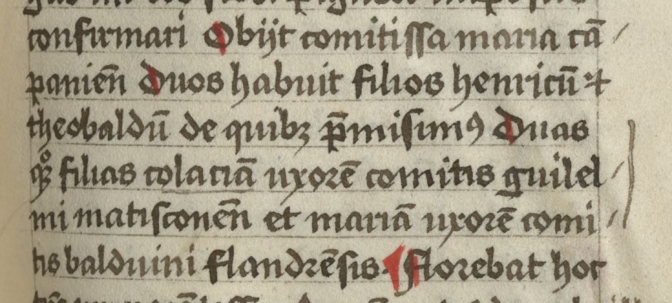
Death of countess Marie, 1198
A fourteenth century copy of the chronicle has a slightly different phrasing saying she had two sons, Henry and Theobald, and “duas filias Colaciam uxorem comitis Baldium Flandren[sis]” [two daughters, Colacia [Scholastique] the wife of count Baldwin of Flanders]. The sentence does not make sense, since it says there were two daughter but then only names one.125
The two versions conflict about the identity of the wife of Baldwin of Flanders, with one saying it was daughter Colacia and the other saying it was daughter Marie. The simplest explanation is that a line was skipped with the version that has Colacia as the wife of Baldwin of Flanders. That explains both the internal inconsistency and the conflict with the other record (and charters and chronicles identifying Baldwin’s wife as Marie). The version that has Marie as the wife of count Baldwin of Flanders must be correct, despite it being a slightly later copy. No other records were found that name Colacia/Scolastica as the wife of Baldwin of Flanders.
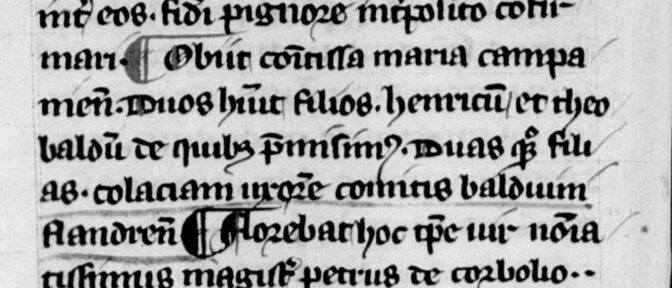
Fragment about Marie’s death and her daughters, 14th century
These four chronicles were created independently of each other, contemporary with the events they described. The surviving copies were created later, but all have the same information. They confirm that Marie of Champagne, countess of Flanders, was the daughter of Henry count of Champagne and Marie of France, countess of Champagne.
Verifying the chronicles
Surviving charters that mention Marie of Champagne, countess of Flanders, do not mention her parents, and are less informative than the chronicles. However, they corroborate other information in the chronicles, which helps to establish their credibility.
A charter from 1198 shows Marie, countess of Flanders and Hainaut, ratifying a donation by the count, her husband.1 This shows that Marie was countess in 1198. The record still has her seal attached.
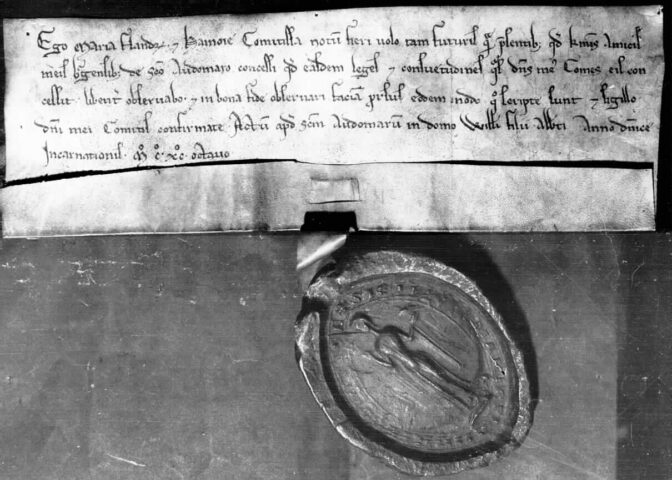
Charter of 1198
In 1199, “B” [Baldwin] count of Flanders and Hainaut and his wife countess “M” [Marie] declared that they donated the tithes of Hulst to the abbey Ter Duinen, in memory of his father Baldwin, his uncle count Philip, and his predecessors.16 The names of his father and uncle match the information in the Chronicle of Hainaut that he was the son of Baldwin had an uncle Philip. The latter arranged his marriage and was an important figure in his life.
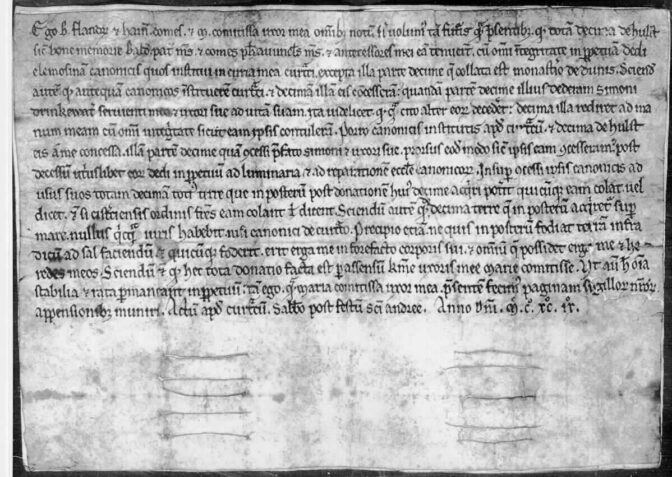
Charter of 1199
In 1202, “M” [Marie], countess of Flanders and Hainaut, issued a charter confirming the gift of the tithe of Mont Sain Genevieve to the nuns of Salzinnes, that her husband the count gave when he was about to depart to Jerusalem.17 This confirms the information from the chronicle by Geoffrey de Villehardouin that Baldwin went on Crusade in 1202 and left before his wife. This charter shows her handling his affairs during his absence.
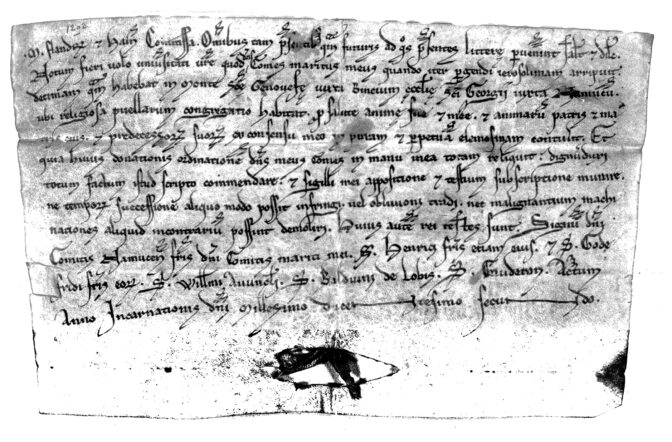
Charter from 1202
In 1203, Maria, countess of Flanders and Hainaut, with the knowledge and approval of her beloved husband Baldwin, count of Flanders and Hainaut, gave a donation to a hospital in Audenarde.18 The charter has her seal.
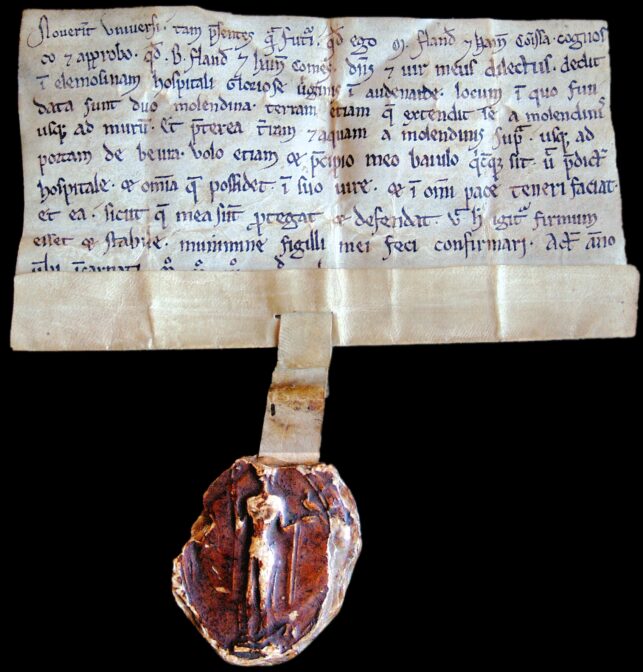
1203 charter
An undated charter, determined to be from between 1202 and 1204, Marie, countess of Flanders and Hainaut, gives a donation to a chapter in Kortrijk, while waiting for her husband’s return.19 That confirms he was away, consistent with him being on crusade. It shows her using the same seal as in 1198.
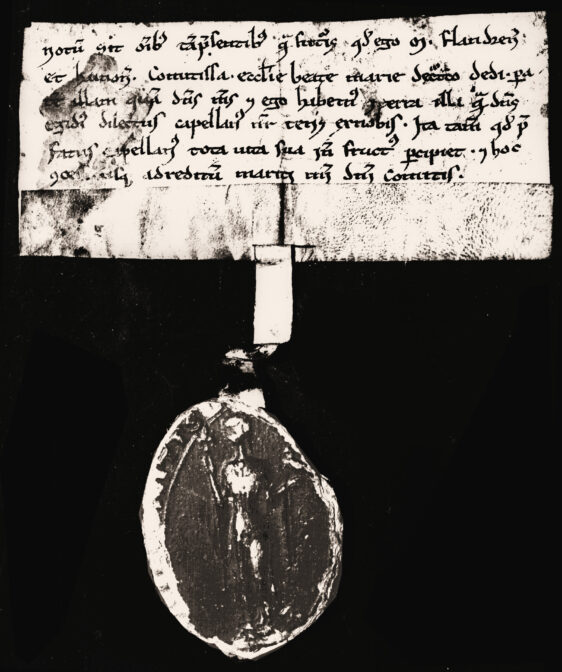
Charter with donation by Marie, countess of Flanders and Hainaut, 1202-1204
Marie countess of Flanders as daughter of count of Troyes
Several charters showed the seal of Marie, countess of Flanders and Hainaut, as seen above. The seal used by Marie in 1203 shows the text “sigilum Flandriae Comitise” [seal of the countess of Flanders] on the front, and “Comitis Trecensis Filie” [daughter of the count of Troyes] on the counter seal on the back.20
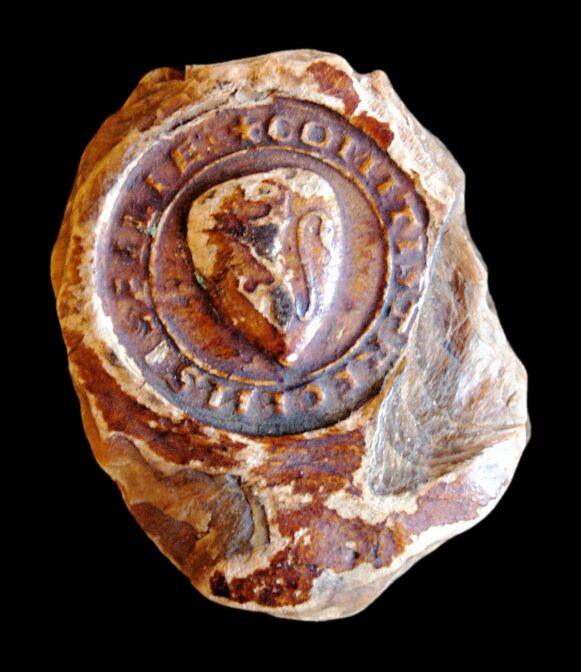
counter-seal, 1203
This same seal was in use by Marie in 1196, as shown in the collection of seal impressions of the National Archives of Belgium.21 This confirms that Baldwin’s wife Marie was the daughter of the count of Troyes, as stated in the chronicles.
Marie of France as wife of Henry count of Champagne
Several sources confirm that the wife of Henry count of Champagne and Troyes was Marie, daughter of King Louis of France. No sources mention another wife for him, suggesting he was only married once.
In 1166, Henry count palatine of Troyes issued a charter. The date translates to “in the year 1166 when Alexander III sat on the Apostolic See of Rome and when Louis, son of King Louis of the Franks, ruled the Kingdom successfully, whose daughter Marie I have in marriage.” This shows that Henry’s wife was Marie, daughter of king Louis of France. The original of this charter was lost. The oldest copy survives in the cartulary of the Abbey of Saint Médard of Soissons from the 13th–14th century.22
In 1179, Henry, count Palatine of Troyes confirmed several possessions and revenues to the St. Nicholas of Sezanne. The charter was witnessed by several people including “Maria etiam comitissa trec[ensis] regis Francorum filia” [also, Marie, countess of Troyes, daughter of the King of France].23 Unfortunately their seals were no longer attached to the charter.
The seal that Marie used as countess of Troyes on other records confirms her identity. The text reads “SIGIL . MARIE . REG . FRANCOR . FILIE . TRECENS . COMITISSE” [the seal of Marie the daughter of the king of France countess of Troyes].24
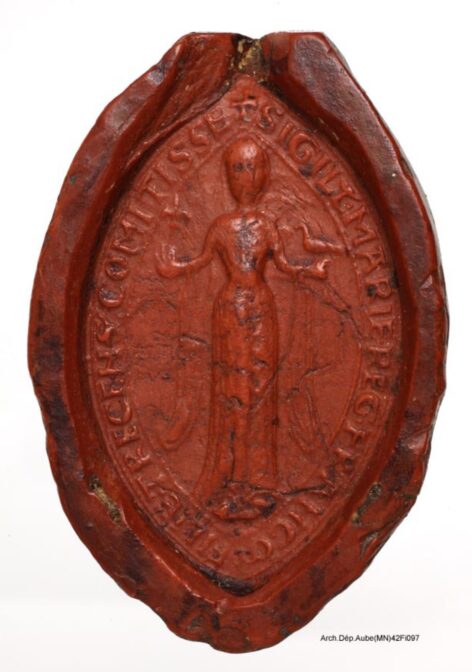
Seal of Marie de France, countess of Troyes
That seal was supposedly also used to authenticate another charter, issued by Marie countess of Champagne in 1197.25 However, when I consulted that charter at the departmental archives in Troyes, the seal was in fragments in a bag, attached by a single thread.26 I did not attempt to take it out of the bag, knowing that would destroy any remaining structure.
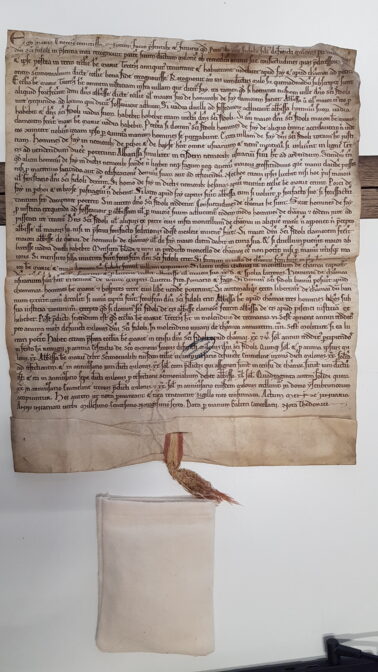
Charter by Marie countess of Champagne, 1197
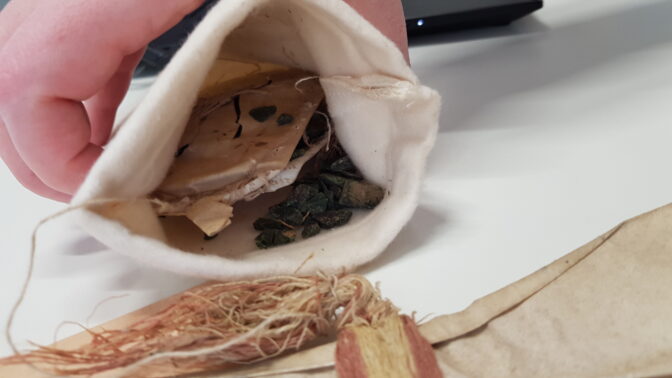
Bag with the fragments of Marie’s seal, 1198.
“Maria comitissa Campanie filia Regis Ludovici Fra[n]con[iae]” [Marie countess of Champagne daughter of king Louis of France] appears in the obituarium [obituary] of Notre-Dame-aux-Nonnains in Troyes on 4 March, implying that was the date of her death.27 Religious institutions kept an obituarium in the form of a calendar. Entries for each day showed the people to commemorate on that day (the date of their deaths). The surviving manuscript dates from 1243–1247 but it copied earlier entries from a no longer extant obituary. This shows masses were said in this convent for the soul of Marie.
Relatives of Philip of France
In November 1198, King Philip of France issued a charter confirming a quitclaim by various nobles to Theobald, count of Champagne, for sums advanced to his [King Philip’s] sister, the late Marie, countess of Champagne, for her son, the late count Henry.28 The charter confirms that the daughter of the King of France who became the countess of Champagne was called Marie. The original charter has been lost, but various later copies survive. A scholarly edition compared the versions and compiled an authoritative transcription.29 The version shown here, from the sixteenth century, erroneously has the date as 1218 instead of 1198.
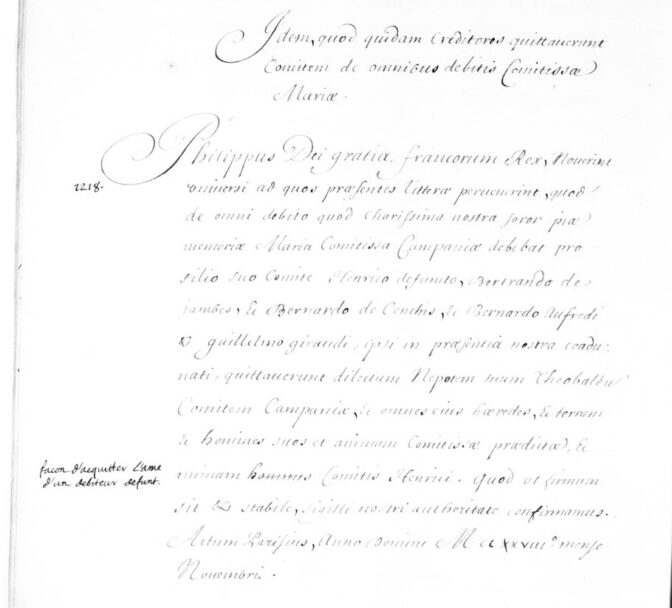
Copy of quitclaim by Philip of France in 1198, manuscript from the 1500s
In 1202, Philip, king of France, at the request of his dear and faithful “neptis” [niece] Marie, countess of Flanders and Hainaut, who acted in stead of her husband count Baldwin, now on pilgrimage to Jerusalem, confirmed records the late Baldwin, count of Flanders.30
Michel Bur researched the terminology used by king Philip of France in relation to Henry II of Champagne and Theobald III of Champagne, the sons of Henry of Champagne and Marie of France. They were both his half-nephews (as sons of Marie of France, the half-sister of Philip) and half-cousins (as sons of Henry of Champagne, brother of Adele of Champagne, the mother of Philip). Philip used the word “nepos” to refer to them, where he used the word “consanguineus” [literally: blood relative] for other first cousins that were not also his half-nephews.31 This emphasized the relationship through his father more than the more distant relationship through his mother. From a dynastic standpoint it also makes sense for him to emphasize the relationship through the king rather than that through the daughter of a count. The use of the term “neptis” [niece] for Marie, countess of Flanders and Hainaut, fits this pattern, and is consistent with her mother being Marie of France, half-sister to king Philip of France.
That Philip of France was the son of Louis of France is confirmed in dozens of records, documenting donations he made in memory of his father.32 Here is one of these records, in a cartulary of Philip of France. This register used abbreviations to record the deeds. The record is issued in the name of “Ph” [Philippus, Latin form of Philip] in memory of “kms genitor” [beloved father] Luds [Ludovicus, the Latin for of Louis].33 The name of Philip’s father matches that of Marie, countess of Champagne, in the obituary and the chronicles.
Conclusion
The seal of Marie, countess of Flanders and Hainaut showed she was the daughter of the count of Troyes. King Philip of France called her his niece, and referred to Marie countess of Champagne as his sister. Charters issued by Henry count of Champagne and Troyes showed he was married to Marie, the daughter of king Louis of France, who was also the father of king Philip of France. Chronicles confirmed that Marie, daughter of Henry of Champagne and Marie of France, married Baldwin count of Flanders and Hainaut, and gave more biographical information. The only conflicting evidence was shown to be the result of a error when the copyist skipped a line. All other sources agree that Marie of Champagne, countess of Flanders and Hainaut, was the daughter of Marie of France, countess of Champagne.
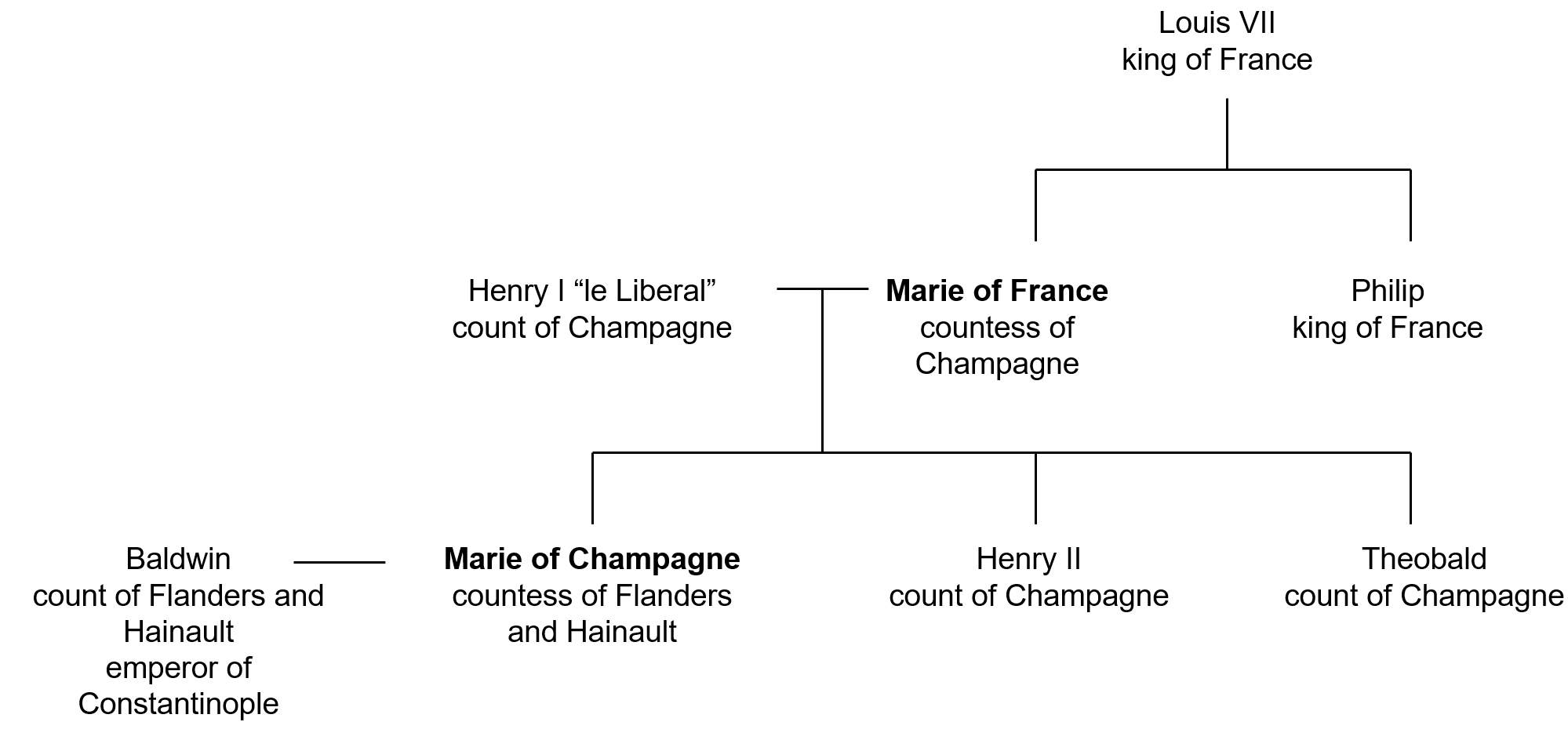
Relationships between people in the article. Possible line to Eleanor in bold.
The research is definitely getting more difficult. It is not hard to find books about these historical figures, but most historians just copy other historians, without going back to the original sources. Standards in genealogy are different than in history, so a lot more work was needed. Most of the original sources were in Latin, allowing me to use my Latin skills that I improved as part of my master’s in Family and Local History at the University of Dundee.
Thankfully, many medieval sources have been transcribed and digitized, so I could do most research online. I love studying the illuminated manuscripts and charters in great detail by zooming in. But even more, I love doing on-site research in France. There is something magical about holding a record created more than 800 years ago. I loved seeing with my own eyes that Marie, countess of Champagne, was the daughter of the King of France. But that King of France had multiple wives, so proving Marie was also the daughter of Eleanor of Aquitaine will be another challenge. I do not yet know if I will need to do more research in France, so it will take me a while to complete the series.
But for now, that’s twenty-seven generations down, only one to go! Soooo close!
Sources
- Theodore Evergates, Marie of France: Countess of Champagne, 1145-1198 (Philadelphia, PA, USA: University of Pennsylvania, 2019), 22.
- Theodore Evergates, Marie of France: Countess of Champagne, 1145-1198 (Philadelphia, PA, USA: University of Pennsylvania, 2019), 54-55.
- Gerben Graddesz Hellinga, Graven van Vlaanderen (Zutphen, Netherlands: Walburg Pers, 2013), 78-81.
- Select bibliography:
Bradford, Ernle. The Great Betrayal: The Great Siege of Constantinople. New York, NY, USA: Open Road media, 2014.
Coppens, Thera. Johanna en Margaretha: Gravinnen van Vlaanderen en Prinsessen van Constantinopel. Amsterdam. Netherlands: Meulenhoff Boekerij, 2019.
De Maesschalck, Edward. De Graven van Vlaanderen (861-1384).Antwerp, Belgium: Davidsfonds, 2019 (pp. 317-350).
Evergates, Theodore. Henry the Liberal: Count of Champagne, 1127-1181. Philadelphia, PA, USA: University of Pennsylvania, 2016.
_____. Marie of France: Countess of Champagne, 1145-1198. Philadelphia, PA, USA: University of Pennsylvania, 2019.
Hellinga, Gerben Graddesz. Graven van Vlaanderen. Zutphen, Netherlands: Walburg Pers, 2013 (pp. 78-81).
Jordan, Erin L. Women, Power, and Religious Patronage in the Middle Ages. New York, NY, USA: Palgrave Macmillan, 2006. - Geoffroi de Villehardouin, La Conquête de Constantinople, manuscript copy, circa 1330, fol. 1r; ms. Laud Misc 587, Bodleian Library, Oxford, UK; imaged at Digital Bodleian (https://digital.bodleian.ox.ac.uk/objects/1dac0552-b0f9-4dc6-82a9-3e94300522d4/surfaces/962343a9-7aa5-4741-9db8-bb4c69b8ef0c/ : accessed 6 June 2022).
- Gislebert de Mons, chronicle of Hainaut, fol 27v, entry for marriage of Marie of Champagne; ms. Latin 11105, Bibliothèque de France, Paris, France; imaged as “Chronique des comtes de Hainaut, par Gilbert de Mons,” Gallica (https://gallica.bnf.fr/ark:/12148/btv1b9076717s/ : accessed 12 February 2021).
- Gislebert de Mons, chronicle of Hainaut, fol 35v, entry for marriage of Marie of Champagne, 1179; ms. Latin 11105, Bibliothèque de France, Paris, France; imaged as “Chronique des comtes de Hainaut, par Gilbert de Mons,” Gallica (https://gallica.bnf.fr/ark:/12148/btv1b9076717s/ : accessed 12 February 2021).
- Léon Vanderkinderen, compiler, La Chronique de Gislebert de Mons (Brussels, Belgium: P. Imbreghts, 1904), xx.
- “Genealogiae Com. Flandriae,” Monumenta Germaniae Historica, vol. SS 9, 329; accessed at dMGH Beta (https://www.dmgh.de/mgh_ss_9/index.htm#page/329/mode/1up: accessed 22 December 2020).
- “Genealogia Comitum Flandrensium,” second half of 12th century, fol. 106r; ms. 769, Bibliothèque d’Agglomération du Pays de Saint-Omer, Saint-Omer, France; imaged, “ACRA,” Institut de Recherche et d’Histoire des Textes (https://arca.irht.cnrs.fr/ark:/63955/md676t055t1v : accessed 18 February 2024).
- Geoffrey de Villehardouin, “L’ystore de lempereur Bauduin de Constantinoble,” fol. 69r; ms. Français 12203, Bibliothèque Nationale de France, Paris, France; imaged, Gallica (https://gallica.bnf.fr/ark:/12148/btv1b10468043c/f143.item.zoom : accessed 15 January 2022).
- Geoffrey de Villehardouin, “L’ystore de lempereur Bauduin de Constantinoble,” fol. 69v-70r; ms. Français 12203, Bibliothèque nationale de France, Paris, France; digital version, Gallica (https://gallica.bnf.fr/ark:/12148/btv1b10468043c/f143.item.zoom : accessed 15 January 2022).For an English translation of the chronicle, see the Medieval Sourcebook at Fordham University.
- Alberic, monk of Trois-Fontaine, “Incipit cronica Alberici trium fontium Leodiensis dyocesis,” copy from late 15th century, fol. 175r; ms. XIII, 748, Gottfried Wilhelm Leibniz Bibliothek, Hannover, Germany; imaged, “Digitale Bibliothek,”Gottfried Wilhelm Leibniz Bibliothek (https://digitale-sammlungen.gwlb.de/resolve?id=1788712005 : accessed 21 February 2024).
- Alberic, monk of Trois-Fontaine, “Chronicon ab orbe condito ad annum Christi 1241: ad calcem subjicitur fragmentum chronici Haynoniensis,” 14th century, fol. 217v; manuscript Latin 4896A, Département des Manuscrits, Bibliothèque nationale de France, Paris, France; imaged at Gallica (https://gallica.bnf.fr/ark:/12148/btv1b9067714k : accessed 1 May 2021).
- Marie of Champagne, ratification of donation to citizens of St. Omer, charter, 1198; imaged at DiBe 364, Diplomata Belgica (https://www.diplomata-belgica.be/charter_details_fr.php?dibe_id=364 : accessed 18 February 2024); citing S.Omer, Archives municipales [AM], AB XVIII, 1.
- Baldwin of Flanders and Hainaut and wife Marie, donation of tithes of Hulst to abbey Ter Duinen, charter, 1199; imaged at DiBe 392, Diplomata Belgica (https://www.diplomata-belgica.be/charter_details_fr.php?dibe_id=392 : accessed 18 February 2024); citing Kortrijk, Rijksarchief [RA], OLV 7.
- Marie of Flanders and Hainaut, donation to the nuns of Salzinnes, charter 1202; imaged at DiBe 13355, Diplomata Belgica (https://www.diplomata-belgica.be/charter_details_fr.php?dibe_id=13355 : accessed 18 February 2024); citing Namur, Archives de l’Etat [AE], Arch. Eccl., n° 3194 A/2, chartes ad datum.
- Marie countess of Flanders to Hospital of Oudenaarde, charter, 1203; imaged at DiBe 13443, Diplomata Belgica (https://www.diplomata-belgica.be/charter_details_en.php?dibe_id=13453 : accessed 22 December 2020); citing Oudenaarde, records of the public center for societal wellbeing (OCMW), fonds Onze-Live-Vrouwehospitaal [Our Dear Lady Hospital] 458.
- Marie of Champagne, donation to Chapter of Notre Dame in Kortrijk, charter, circa 1202-1204; imaged at DiBe 13516, Diplomata Belgica (https://www.diplomata-belgica.be/charter_details_fr.php?dibe_id=13516 : accessed 18 February 2024); citing Kortrijk, Rijksarchief [RA], OLV 12.
- Marie countess of Flanders to Hospital of Oudenaarde, charter, 1203; imaged at DiBe 13443, Diplomata Belgica (https://www.diplomata-belgica.be/charter_details_en.php?dibe_id=13453 : accessed 22 December 2020); citing Oudenaarde, records of the public center for societal wellbeing (OCMW), fonds Onze-Live-Vrouwehospitaal [Our Dear Lady Hospital] 458.
- Imprint of the seal of Marie of Champagne, wife of Baldwin IX, count of Flanders, 22 June 1196; call no. 21729, collection of seals of the national archives, Record group I 347, National Archives of Belgium, Brussels; “Collection de moulages de sceaux des Archives générales du Royaume,” finding aid and images, The State Archives in Belgium (https://search.arch.be/nl/zoeken-naar-archieven/zoekresultaat/inventaris/rabscans/eadid/BE-A0510_005990_005868_FRE/inventarisnr/I599058683916762 : accessed 17 September 2020). Also Imprint of the counter seal of Marie of Champagne, 22 June 1196; call no. 21730, I 347.
- Abbey of Saint-Médard de Soisson, cartulary, 13th–14th century, fol. 16v–17v, act of Henri count Palatine of Troyes, 1166; imaged, “ARCA,” Institut de Recherche et d’Histoire des Textes (https://arca.irht.cnrs.fr/ark:/63955/md042r36v608 : accessed 26 February 2024); citing France, Laon, Archives départementales de l’Aisne – H 477.
- Henry count palatine of Troyes, charter, donation and revenues to Saint Nicolas de Sézanne, 1179; ms. G 1310, Archives Départementales de la Marne, Chalons-en-Champagne, France.
- Seal of Marie of France countess of Troyes, 1192-1197; imaged at “Collection de sceaux détachés,” Aube en Champagne, Archives Departementales (https://www.archives-aube.fr/recherches/recherche-globale?detail=580797 : accessed 18 February 2024); citing 42 Fi 97 AN, sc/Ch 52-3.
- “Collections,” Sigilla: Base numériques des sceaux conservés en France (http://www.sigilla.org/acte/ad-10-22-h-1512-6464 : accessed 10 February 2022), entry for acte Ad 10 – 22 H 1512.
- Marie countess of Champagne, charter, confirmation of donation to the Saint Mary’s church in Troyes, January 1196/7; call no. 22 H 1512, Archives Départementales de l’Aube, Troyes, France.
- “Obituarium Ad Usum Monasterii Beatae Mariae Ad Moniales Trecensis,” manuscript, 1243–1247, fol. 7r; ms. Latin 9894, Département des Manuscrits, Bibliothèque nationale de France, Paris, France; imaged, “Gallica,” Bibliothèque nationale de France (https://gallica.bnf.fr/ark:/12148/btv1b531882495 : accessed 28 February 2024).
- “Registrium Principum Campaniae,” 16th century, fol. 258v, entry for confirmation of quitclaim to Theobald of Champagne, November 1198; ms. Cinq Cents de Colbert 58, Bibliothèque Nationale de France, Paris, France; “Gallica,” images, Bibliothèque nationale de France (https://gallica.bnf.fr/ark:/12148/btv1b100340931/ : accessed 18 February 2024).
- Henri-François Delaborde, ed., Recueil Des Actes de Philippe-Auguste, Roi de France, vol. 1, 2 vols. (Paris, France: Impr. nationale, 1916).
- Saint Pierre, Lille, cartulary of the deacons, 13th century, entry for charter of Philip, King of France, confirming donations by Baldwin count of Flanders, 1202; imaged, “ARCA,” Institut de Recherche et d’Histoire des Textes (https://arca.irht.cnrs.fr/ark:/63955/md60cv43rd8v : accessed 12 March 2024); citing France, Lille, Médiathèque Jean Levy – Ms 205 (CGM 658).
- Michel Bur, “Capétiens et Thibaudiens autour de 1198: Neveux ou cousins?”, La Champagne médiévale: recueil d’articles (Langres: Dominique Guéniot, 2005), 97-108.
- Henri-François Delaborde, ed., Recueil Des Actes de Philippe-Auguste, Roi de France, vol. 1, 2 vols. (Paris, France: Impr. nationale, 1916), 1-75.
- Cartulary of Philippe-August, called “Registrum ad nudos asseres de quercu,” 13th century, fol. 44v; imaged, “ARCA,” Institut de Recherche et d’Histoire des Textes (https://arca.irht.cnrs.fr/ark:/63955/md687h14bc65 : accessed 12 Maarch 2024); citing France, Paris, Archives nationales, JJ 7.

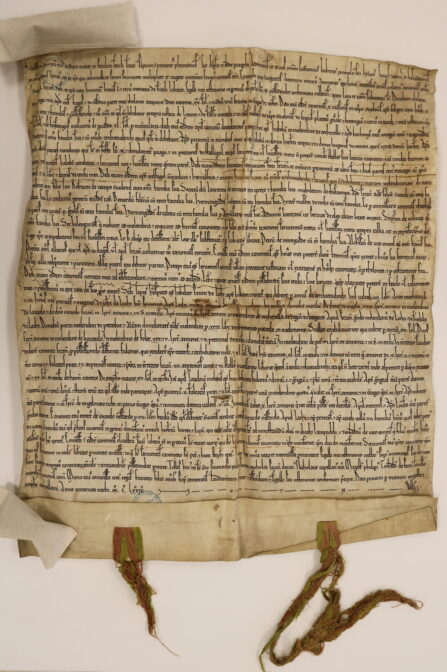
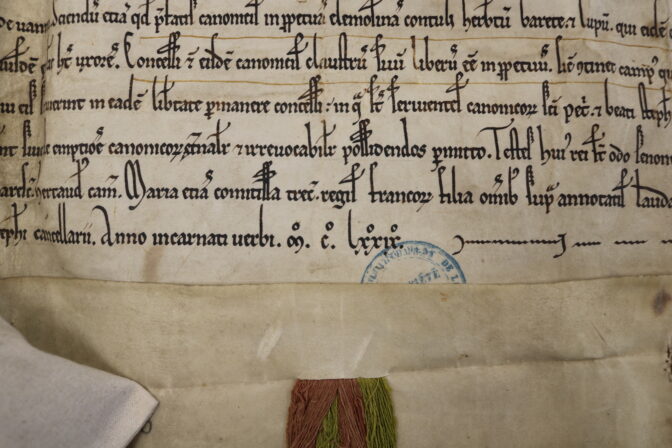

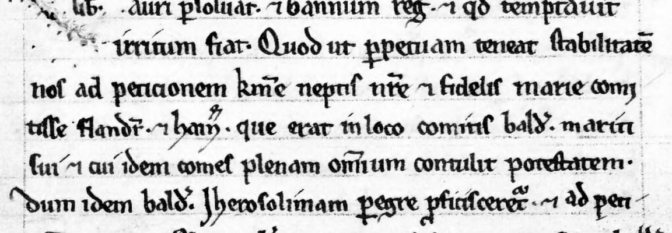
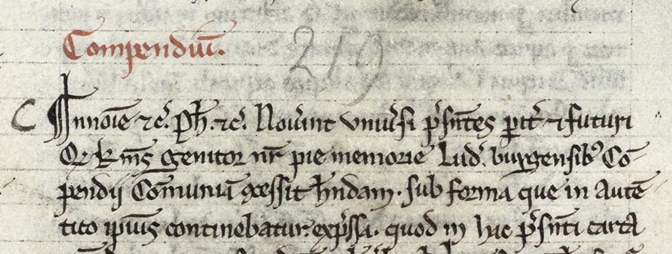


This whole project is very impressive!
So pleased to see your research, Yvette. Read Avery word!
This is impressive! I’m only thirteen but I am so inspired by your research, I hope one day I can be as skilled and talented as you 🙂